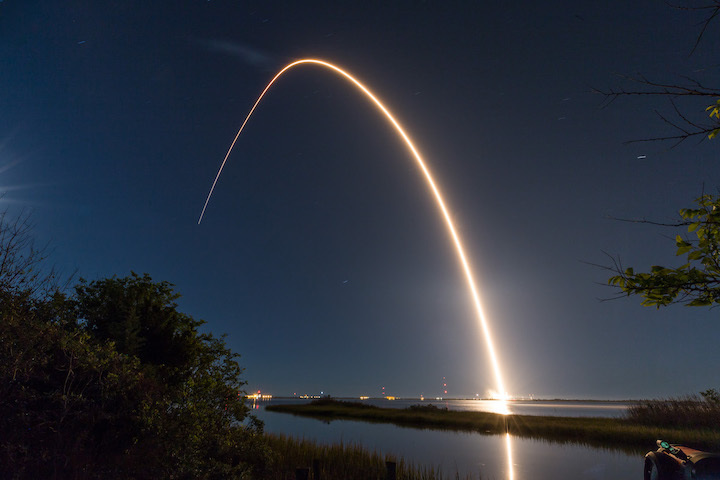4.10.2020

A Northrop Grumman Cygnus supply ship rocketed into orbit from Virginia Friday night on an Antares launcher, taking aim on the International Space Station with an advanced $23 million zero-gravity titanium toilet and several tons of other gear.
The 139-foot-tall (42.5-meter) Antares rocket took off from pad 0A at the Mid-Atlantic Regional Spaceport on Virginia’s Eastern Shore at 9:16:14 p.m. EDT Friday (0116:14 GMT Saturday) on the first leg of a two-and-a-half day pursuit of the space station.
Delayed from earlier in the week by poor weather and a ground software issue that scrubbed a countdown Thursday, the Antares rocket arced toward the southeast on the power of its twin Russian-made RD-181 main engines.
The engines throttled up to produce 864,000 pounds of thrust for more than three minutes, then the Antares rocket’s first stage detached to fall into the Atlantic Ocean. Moments later, a solid-fueled upper stage ignited to accelerate the Cygnus spacecraft to orbital velocity near 17,000 mph (27,000 kilometers) per hour.
Nearly nine minutes after liftoff, the 7,459-pound (7,919-kilogram) Cygnus spaceship deployed from the Antares upper stage. A couple of hours later, Northrop Grumman confirmed the cargo freighter’s two fan-shaped solar arrays unfurled to begin generating electricity.
Multiple engine burns by the Cygnus spacecraft will maneuver the supply ship into the vicinity of the space station Monday. Once it reaches a point around 30 feet, or 9 meters, below the complex, NASA astronaut Chris Cassidy will take control of the lab’s Canadian-built robotic arm around 5:20 a.m. EDT (0920 GMT) Monday to grapple the Cygnus spacecraft and berth it to the space station’s Unity module.
Northrop Grumman named the Cygnus spacecraft the S.S. Kalpana Chawla, honoring one of the astronauts who perished on the space shuttle Columbia in 2003.
“Kalpana was the first female astronaut of Indian descent,” said Frank DeMauro, vice president and general manager of Northrop Grumman’s tactical space programs. “We are really honored to name this mission after her, and all the contributions which she’s made to the human spaceflight program, someone who hame to the U.S., became a naturalized citizen, then became an astronaut and flew into space twice.”
The S.S. Kalpana Chawla is packed with 7,829 pounds (3,551 kilograms) of supplies and experiments heading to the International Space Station. Here’s a breakdown of the cargo manifest provided by NASA:
- 2,712 pounds (1,230 kilograms) of vehicle hardware
- 2,683 pounds (1,217 kilograms) of scientific investigations
- 1,874 pounds (850 kilograms) of crew supplies
- 333 pounds (151 kilograms) of spacewalk equipment
- 156 pounds (71 kilograms) of computer resources
The Cygnus supply ship will remain berthed Unity module until mid-December, when it will be released by the station’s robotic arm. The automated cargo carrier, loaded with trash after its departure from the station, will perform an in-flight combustion experiment before re-entering the atmosphere and burning up over the South Pacific Ocean to end its mission.
Flying under contract to NASA, the mission marks Northrop Grumman’s 14th commercial resupply launch to the space station overall since 2014, including Cygnus missions flown by predecessor companies Orbital Sciences and Orbital ATK.
The fresh food packed inside the S.S. Kalpana Chawla supply ship includes prosciutto, chorizo, salami, summer sausage, brie, smoked gouda, smoked provolone, and fruits and vegetables.
Among clothing and other crew provisions, the Cygnus mission will deliver an upgraded toilet to the space station, allowing astronauts to test its functionality before a similar commode flies on the Orion crew capsule to the moon.
The new toilet, or Universal Waste Management System in NASA-speak, is roughly the size of a camper commode. It’s about 65 percent smaller and 40 percent lighter than the toilet currently on the space station, according to Melissa McKinley, logistics reduction manager for the agency’s advanced exploration systems division.

NASA partnered with Collins Aerospace to develop the new toilet, which officials said is better suited for female crew members than the existing commode on the space station. Engineers made parts of the toilet out of titanium to withstand acid used to pre-treat urine before the fluid is recycled back into drinking water for the astronauts, said Jim Fuller, the toilet’s project manager at Collins Aerospace.

There’s also a virtual reality camera flying to the space station that will capture imagery of a future spacewalk.
The cosmetics company Estée Lauder is also flying 10 bottles of its “Advanced Night Repair” serum to the space station, where the bottles will be photographed with Earth as a backdrop. Estée Lauder says it will use the images in social media and marketing campaigns, and then plans to auction the serum returned to Earth from the space station, with the proceeds going to charity.
It’s part of a new NASA program that dedicates 5 percent of space station cargo capacity and crew time to commercial marketing activities. Estée Lauder will reimburse NASA around $128,000 for the space station resources used in the night serum marketing initiative, according to Phil McAlister, NASA’s director of commercial spaceflight development.
Northrop Grumman’s Cygnus spacecraft shares space station resupply duties with SpaceX’s Dragon capsule, the Russian Progress resupply freighter, and Japanese cargo missions.
Quelle: SN
